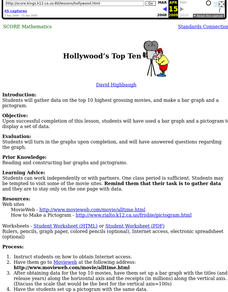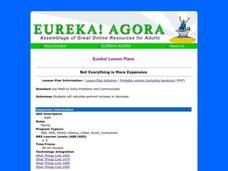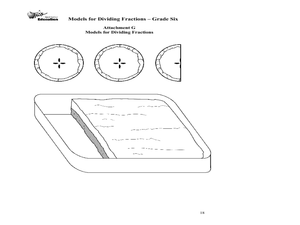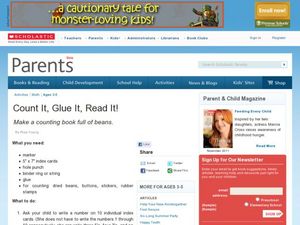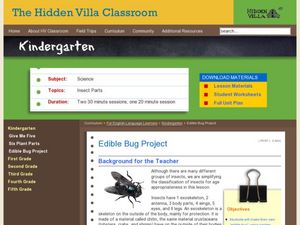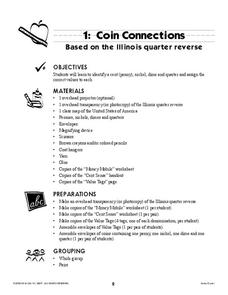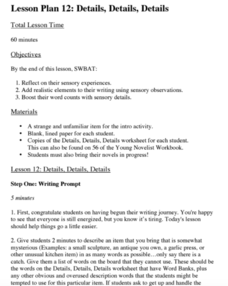Curated OER
Start at the Very Beginning
Students explore ocean ecosystems. In this cross curriculum art and oceans lesson, students create a collage featuring three-finger algae using sand paper, tissue paper, and construction paper.
Curated OER
School Life Today and in the Past at Freyberger School
Students compare and contrast school life today with that of Pennsylvania in the 1900's. In this school life lesson students create a description of a typical one-room schoolhouse. They think critically about attending school in a...
Curated OER
Hollywood's Top Ten
Students gather data on top 10 highest grossing movies, and make a bar graph and a pictogram.
Curated OER
Five Senses
Students listen to the book "My Five Senses." They work together to classify fifteen objects by the sense that they affect. They discuss the sense organs and complete a chart. Finally, they sort mystery items from a bag which the teacher...
Curated OER
Seeing and Hearing Game
Students study the animal senses. In this animal senses lesson, students act out animal movements and make animal sounds. They use "see and hear" cards to play a game in which they find another child with a either "make a sound or...
Curated OER
"The Patchwork Quilt" by Valerie Flournoy pictures by Jerry Pinkney
Students recognize squares and find a pattern for counting squares.
Curated OER
Not Everything Is More Expensive
Students investigate the concept of using different types of presentations to help solve mathematical problems. They research the use of illustrations to help understand data and its interpretation in a graphing format. Students also...
Curated OER
Observing Apples - Skill Lesson
First graders listen to a story about Johnny Appleseed read by their teacher. They discuss his life as a class and describe what they see when a cut apple is before them. They draw a picture of what they see and write three adjectives...
Curated OER
When Trees Are Red, Color in Remote Sensing
Student learn about "chromatography" in a hands-on experiment. Students make a chart showing what the colors represent.
Curated OER
Extreme Elevations
Seventh graders use highest and lowest points of land elevation around the world to find the differences. Sea level is zero, so students be operating with positive and negative numbers. After students find the information on the...
Curated OER
Pascal's Triangle
Young scholars explore the concept of Pascal's Triangle. In this Pascal's Triangle lesson, students use an applet called 'Coloring Multiples' to explore Pascal's Triangle. Young scholars develop patterns starting with various numbers in...
Curated OER
Numbers and Operations
Students practice using proportions to discover the fraction needed to use the right amount of an ingredient. They calculate the number of ounces in one gallon as well. They answer questions to complete the lesson plan.
Curated OER
Human Fingerprints: No Two The Same
Learners will be offered numerous opportunities to further enhance their observational skills as well as the integration of math with their continual exposure to the metric system, measurement, and graphing to represent their data....
Curated OER
Savings Account Introduction Lesson
This teaching tool promotes a practical understanding of basic mathematical skills by having learners determine percents on interest. There are several worksheet options available as well as a guid on how best to use them.
Ohio Department of Education
Models for Dividing Fractions - Grade Six
Fifth and sixth graders use food and candy to help them represent division of fractions and develop algorithms to solve fraction problems. They discuss dividing whole numbers by fractions. Pupils use sticks and chocolate bars to...
Curated OER
50 State Quarter Game
Students, using their knowledge of place value and number sense, play this counting game in small groups, or as a whole class, to see who be the first person to reach 50 cents.
Curated OER
Do You Have Number Sense?
Seventh graders are grouped according to their ability level with a captain who is elected by the students in that particular group. Students demonstrate their knowledge of rational and irrational numbers by defining them. Students use a...
Curated OER
Count it, Glue it, Read it!
Young scholars identify numbers 1-10 and count objects to match corresponding numbers. In the number sense lesson, students create a counting book, matching numbers they've written on index cards with the correct number of items (beans,...
Annenberg Foundation
Electoral Politics
You won't just get a lesson when you click on this resource. As you click on the related resources located to the left of the screen, you'll find, a professional development video, teacher/student notes, lesson plan, and related...
Curated OER
Edible Bug Project
Students recognize the characteristics of insects. In this edible bugs lesson, students observe the body parts of an insect. Students create an edible insect using a grape, carrot sticks and sorrel stems and leaves. ...
Curated OER
Coin Connections
A wonderful lesson on identifying the penny, nickel, dime, and quarter awaits your young mathematicians. They engage in a multi-session lesson which allows them to practice using the values of each coin in worksheets and activities...
Curated OER
Details, Details, Details
Writing can become one-dimensional if authors don't involve all their senses. First, scholars observe a strange object which, ideally, they can touch and even smell. Without using certain words (you can create a list or have the class...
Curated OER
Name That Taste
Young scholars analyze taste buds. In this taste lesson, students complete an experiment in groups of four people. Young scholars have four cups with a different substance in each cup. One student dips a Q-tip into each cup and tests on...
Curated OER
The Beginnings of Constitutional Government
Students examine excerpts of Thomas Paine's Common Sense. In this early American history lesson, students read Paine's pamphlet and analyze the information according the rubric provided.


